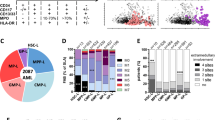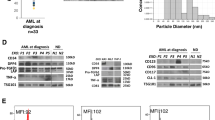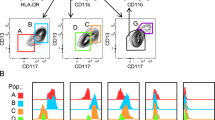Abstract
CD44 is an adhesion molecule that is expressed on hematopoietic cells and has been implicated in the interactions between bone marrow stromal layers and hematopoietic progenitors. The expression of variant forms of CD44, particularly forms containing exon v6, have been associated with poor prognosis in a number of hematological malignancies. The expression of CD44 variants on normal bone marrow (BM), peripheral blood (PBMC) and CD34+ hematopoietic progenitors was compared with those expressed on blasts from 30 patients with acute myeloid leukemia (AML). Normal BM, PBMC and CD34+ progenitor cells were negative for all variants tested by flow cytometry. In contrast exon v3 was expressed on 13%, v4 on 67%, v5 on 19%, v6 on 7% and v7 on 65% of AML cases. RT-PCR and Southern blotting revealed the expression of exons v3, v6, v8, v9 and v10 in normal bone marrow and peripheral blood mononuclear cells and the expression of exons v3, v6, v8 and v10 in CD34+progenitors. A more complex pattern of variant exon expression was observed in leukemic samples in comparison to normal hematopoietic cells. Sixty-two percent of AML cases expressed exon v3 and 70% exon v6. Exons v4 and v5 were not detected while exons v7, v8, v9 and v10 were detected in 21, 83, 71 and 92% of cases, respectively. In summary, our data demonstrate a striking increase in the complexity of CD44 variant expression in cells from patients with AML, along with surface expression of some variant CD44 proteins. Further analysis will be directed at how these alter the interaction of leukemic blasts with the bone marrow microenvironment and their diagnostic, prognostic and therapeutic potential.
This is a preview of subscription content, access via your institution
Access options
Subscribe to this journal
Receive 12 print issues and online access
$259.00 per year
only $21.58 per issue
Buy this article
- Purchase on SpringerLink
- Instant access to full article PDF
Prices may be subject to local taxes which are calculated during checkout




Similar content being viewed by others
References
Underhill C . CD44: the hyaluronan receptor J Cell Sci 1992 103: 293–298
Droll A, Dougherty S, Chiu R, Dirks J, McBride W, Cooper D, Dougherty G . Adhesive interactions between alternatively spliced CD44 isoforms J Biol Chem 1995 270: 11567–11573
Elamin T, Smith L, Griffioen A, Schilder-Tol E, Borst J, Pals S . Signalling through CD44 is mediated by tyrosine kinases J Biol Chem 1996 271: 2863–2867
Shimizu Y, van Seventer GA, Siraganian R, Wahl L, Shaw S . Dual role of the CD44 molecule in T cell adhesion and activation J Immunol 1989 143: 2457–2463
Denning S, Le P, Singer K, Haynes B . Antibodies against the CD44p80, lymphocyte homing receptor molecule augment human peripheral blood T cell activation J Immunol 1990 144: 7–15
Ghaffari S, Dougherty G, Eaves A, Eaves C . Diverse effects of anti-CD44 antibodies on the stromal cell-mediated support of normal but not leukaemic (CML) haemopoiesis in vivo Br J Haematol 1997 97: 22–28
Miyake K, Medina KL, Hayashi S-I, Ono S, Hamaoka T, Kincade PW . Monoclonal antibodies to Pgp-1/CD44 block lymphohemopoiesis in long-term bone marrow cultures J Exp Med 1990 171: 477–488
Rossbach H-C, Krizanac-Bengez L, Santos E, Gooley T, Sandmaier B . An antibody to CD44 enhances hematopoiesis in long-term marrow cultures Exp Hematol 1996 24: 221–227
Sandmaier B, Storb R, Appelbaum F, Gallatin W . An antibody that facilitates hematopoietic engraftment recognizes CD44 Blood 1990 76: 630–635
Screaton G, Bell M, Jackson D, Cornelis F, Gerth U, Bell J . Genomic structure of DNA encoding the lymphocyte homing receptor CD44 reveals at least 12 alternatively spliced exons Proc Natl Acad Sci USA 1992 89: 12160–12164
Dougherty G, Landsorp P, Cooper D, Humpheries R . Molecular cloning of CD44R1 and CD44R2, two novel isoforms of the human CD44 lymphocyte homing receptor expressed by hematopoietic cells J Exp Med 1990 174: 1–5
Mackay C, Terpe H-J, Stauder R, Marston W, Stark H, Günthert U . Expression and modulation of CD44 variant isoforms in humans J Cell Biol 1994 124: 71–82
Arch R, Wirth K, Hofmann M, Ponta H, Matzku S, Herrlich P, Zoller M . Participation in normal immune responses of a metastasis-inducing splice variant of CD44 Science 1992 257: 682–685
Koopman G, Heider K, Horst E, Adolf G, van den Berg F, Ponta H, Herrlich P, Pals S . Activated human lymphocytes and aggressive non-Hodgkin's lymphomas express a homologue of the rat metastasis-associated variant of CD44 J Exp Med 1993 177: 897–904
Stauder R, Eisterer W, Thaler J, Gunthert U . CD44 variant isoforms in non-Hodgkin's lymphoma: a new independent prognostic factor Blood 1995 85: 2885–2899
Stauder R, Van Driel M, Schwarzler C, Thaler J, Lokhorst H, Kreuser E, Bloem A, Gunthert U, Eisterer W . Different CD44 splicing patterns define prognostic subgroups in multiple myeloma Blood 1996 88: 3101–3108
Kaufmann M, Heider K-H, Sinn H-P, von Minckwitz G, Ponta H, Herrlich P . CD44 variant exon epitopes in primary breast cancer and length of survival Lancet 1995 345: 615–619
Heider K-H, Dämmrich J, Skroch-Angel P, Müller-HermelinkH-K, Vollmers H, Herrlich P, Ponta H . Differential expression of CD44 splice variants in intestinal-and diffuse-type human gastric carcinoma and normal gastric mucosa Cancer Res 1993 53: 4197–4203
Terpe H-J, Koopmann R, Imhof B, Günthert U . Expression of integrins and CD44 isoforms in non-Hodgkin's lymphomas: CD44 variant isoforms are preferentially expressed in high-grade malignant lymphomas J Pathol 1994 174: 89–100
Mulder J-W, Kruyt P, Sewnath M, Oosting J, Seldenrijk C, Weidema W, Offerhaus G, Pals S . Colorectal cancer prognosis and expression of exon-v6-containing CD44 proteins Lancet 1994 344: 1470–1472
Tempfer C, Lösch A, Heinzel H, Häusler G, Hanzal E, Kölbl H, Breitenecker G, Kainz C . Prognostic value of immunohistochemically detected CD44 isoforms CD44v5, CD44v6 and CD44v7–8 in human breast cancer Eur J Cancer 1996 32A: 2023–2025
Bartolazzi A, Jackson D, Bennett K, Aruffo A, Dickinson R, Shields J, Whittie N, Stamenkovic I . Regulation of growth and dissemination of a human lymphoma by CD44 splice variants J Cell Sci 1995 108: 1723–1733
Ghaffari S, Dougherty G, Lansdorp P, Eaves A, Eaves C . Differentiation-associated changes in CD44 isoform expression during normal hematopoiesis and their alteration in chronic myeloid leukemia Blood 1995 86: 2976–2985
Legras S, Günthert U, Stauder R, Curt F, Oliferenko S, Kluin-Nelemans H, Marie P, Proctor S, Jasmin C, Smadja-Joffe F . A strong expression of CD44-6v correlates with shorter survival of patients with acute myeloid leukemia Blood 1998 91: 3401–3413
Kortlepel K, Bendall LJ, Gottlieb DJ . Human acute myeloid leukemia cells express adhesion proteins and bind to bone marrow fibroblast monolayers and extracellular matrix proteins Leukemia 1993 7: 1174–1179
Bendall L, Kirkness J, Hutchinson A, Bianchi A, Makrynikola V, Bradstock K, Gottlieb D . Antibodies to CD44 enhance adhesion of normal CD34+ cells and acute myeloblastic but not lymphoblastic leukaemia cells to bone marrow stroma Br J Haematol 1997 98: 828–837
Stamenkovic I, Amiot M, Pesando J, Seed B . A lymphocyte molecule implicated in lymph node homing is a member of the cartilage link protein family Cell 1989 56: 1057–1062
Hofmann M, Rudy W, Zöller M, Tölg C, Ponta H, Herrlich P, Günthert U . CD44 splice variants confer metastatic behavior in rats: homologous sequences are expressed in human tumor cell lines Cancer Res 1991 51: 5292–5297
Verfaillie CM . Direct contact between human primitive hemopoietic progenitors and bone marrow stroma is not required for long-term in vitro hemopoiesis Blood 1992 79: 2821–2826
Schmits R, Filmus J, Gerwin N, Senaldi G, Kiefer F, Kundig T, Wakeham A, Shahinian A, Catzavelos C, Rak J, Furlonger C, Zakarian A, Simard J, Ohashi P, Paige C, Gutierrez-Ramos J, Mak T . CD44 regulates hematopoietic progenitor distribution, granuloma formation, and tumorigenicity Blood 1997 90: 2217–2233
Khaldoyanidi S, Denzel A, Zöller M . Requirement for CD44 in proliferation and homing of hematopoietic precursor cells J Leuk Biol 1996 60: 579–592
Sleeman J, Kondo K, Ponta H, Herrlich P . Variant exons v6 and v7 together expand the repertoire of glycosaminoglycans bound by CD44 J Biol Chem 1997 272: 31837–31844
Wielenga V, van der Voort R, Mulder J, Kruyt P, Weidema W, Oosting J, Seldenrijk C, van Krimpen C, Offerhaus G, Pals S . CD44 splice variants as prognostic markers in colorectal cancer Scand J Gastroenterol 1998 33: 82–87
Khaldoyanidi S, Achtnich M, Hehlmann R, Zöller M . Expression of CD44 variant isoforms in peripheral blood leukocytes in malignant lymphoma and leukemia: inverse correlation between expression and tumor progression Leukemia Res 1996 20: 839–851
Ghaffari S, Dougherty G, Eaves A, Eaves C . Altered patterns of CD44 epitope expression in human chronic and acute myeloid leukemia Leukemia 1996 10: 1773–1781
Goodison S, Yoshida K, Sugino T, Woodman A, Gorham H, Bolodeoku J, Kaufmann M, Tarin D . Rapid analysis of distinctive CD44 RNA splicing preferences that characterize colonic tumors Cancer Res 1997 57: 3140–3144
Dall P, Heider K-H, Hekele A, von Minckwitz G, Kaufmann M, Ponta H, Herrlich P . Surface protein expression and messenger RNA-splicing analysis of CD44 in uterine cervical cancer and normal cervical epithelium Cancer Res 1994 54: 3337–3341
Terpe H-J, Störkel S, Zimmer U, Anquez V, Fischer C, Pantel K, Günthert U . Expression of CD44 isoforms in renal cell tumors Am J Pathol 1996 148: 453–463
Bolodeoku J, Yoshida K, Sugino T, Goodison S, Tarin D . Accumulation of immature intron-containing CD44 gene transcripts inbreast cancer tissues Mol Diagn 1996 1: 175–181
Stickeler E, Mobus V, Kieback D, Kohlberger P, Runnebaum I, Kreienberg R . Intron 9 retention in gene transcripts suggests involvement of CD44 in the tumorigenesis of ovarian cancer Anticancer Res 1997 17: 4395–4398
Matsumura Y, Sugiyama M, Matsumura S, Hayle A, Robinson P, Smith J, Tarin D . Unusual retention of introns in CD44 gene transcripts in bladder cancer provides new diagnostic and clinical oncological opportunities J Pathol 1995 177: 11–20
Yoshida K, Bolodeoku J, Sugino T, Goodison S, Matsumura Y, Warren B, Toge T, Tahara E, Tarin D . Abnormal retention of intron 9 in CD44 gene transcripts in human gastrointestinal tumors Cancer Res 1995 55: 4273–4277
Charrad R, Li Y, Delpech B, Balitrand N, Clay D, Jasmin C, Chomienne C, Smadja-Joffe F . Ligation of the CD44 adhesion molecule reverses blockage of differentiation in human acute myeloid leukemia Nature Med 1999 5: 669–676
Lackner C, Moser R, Bauernhofer T, Wilders-Trusching M, Samonigg H, Berghold A, Zatloukal K . Soluble CD44 v5 and v6 in serum of patients with breast cancer. Correlation with expression of CD44 v5 and v6 variants in primary and location of distant metastasis Breast Cancer Res Treat 1998 47: 29–40
Rall C, Rustgi A . CD44 isoform expression in primary and metastatic pancreatic adenocarcinoma Cancer Res 1995 55: 1831–1835
Yakushijin Y, Steckel J, Kharbanda S, Hasserjian R, Neuberg D, Jiang W, Shipp M . A directly spliced exon 10-containing CD44 variant promotes the metastasis and homotypic aggregation of aggressive non-Hodgkin's lymphoma Blood 1998 91: 4282–4291
Gadducci A, Ferdeghini M, Fanucchi A, Annicchiarico C, Cosio S, Prontera C, Bianchi R, Genazzani A . Serum assays of soluble CD44 standard (sCD44-st), CD44 splice variant v5 (sCD44-v5), and CD44 splice variant v6 (sCD44-v6) in patients with epithelial ovarian cancer Anticancer Res 1997 17: 4463–4466
Bahar R, Kunishi M, Kayada Y, Yoshiga K . CD44 variant v6 (CD44v6) expression as a progression marker in benign, premalignant and malignant oral epithelial tissues Int J Oral Max Surg 1997 26: 443–446
Acknowledgements
This research was supported by the National Health and Medical Research Council of Australia and the Leo and Jenny Research Foundation. We wish to thank Mary Sartor for performing FACS sorting.
Author information
Authors and Affiliations
Rights and permissions
About this article
Cite this article
Bendall, L., Bradstock, K. & Gottlieb, D. Expression of CD44 variant exons in acute myeloid leukemia is more common and more complex than that observed in normal blood, bone marrow or CD34+ cells. Leukemia 14, 1239–1246 (2000). https://doi.org/10.1038/sj.leu.2401830
Received:
Accepted:
Published:
Issue date:
DOI: https://doi.org/10.1038/sj.leu.2401830
Keywords
This article is cited by
-
Flow cytometric quantification and immunophenotyping of leukemic stem cells in acute myeloid leukemia
Annals of Hematology (2012)
-
High levels of the adhesion molecule CD44 on leukemic cells generate acute myeloid leukemia relapse after withdrawal of the initial transforming event
Leukemia (2011)
-
Epigenetic regulation of CD44in Hodgkin and non-Hodgkin lymphoma
BMC Cancer (2010)
-
Conservation of CD44 exon v3 functional elements in mammals
BMC Research Notes (2008)
-
Targeting of CD44 eradicates human acute myeloid leukemic stem cells
Nature Medicine (2006)



